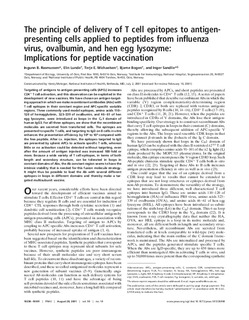| dc.description.abstract | Targeting of antigens to antigen-presenting cells (APCs) increases CD4(+) T cell activation, and this observation can be exploited in the development of new vaccines. We have chosen an antigen-targeting approach in which we make recombinant antibodies (Abs) with T cell epitopes in their constant region and APC-specific variable regions. Three commonly used model epitopes, amino acids 110-120 of hemagglutinin, 323-339 of ovalbumin, and 46-61 of hen egg lysozyme, were introduced as loops in the C(H)1 domain of human IgG3. For all three epitopes, we show that the recombinant molecules are secreted from transfected cells. The epitopes are presented to specific T cells, and targeting to IgD on B cells in vitro enhances the presentation efficiency by 10(4) to 10(5) compared with the free peptide. After i.v. injection, the epitopes targeted to IgD are presented by splenic APCs to activate specific T cells, whereas little or no activation could be detected without targeting, even after the amount of antigen injected was increased 100-fold or more. Because a wide variety of T cell epitopes, in terms of both length and secondary structure, can be tolerated in loops in constant domains of Abs, the Ab constant region seems to have the intrinsic stability that is needed for this fusion molecule strategy. It might thus be possible to load the Ab with several different epitopes in loops in different domains and thereby make a targeted multisubunit vaccine. | |
